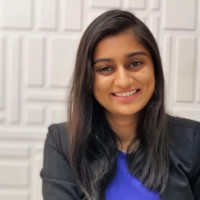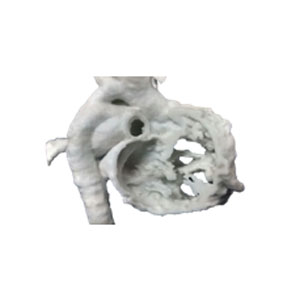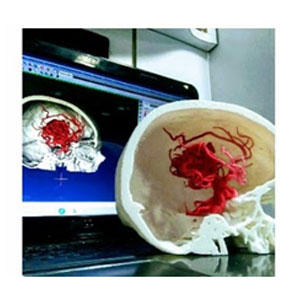OEMs, materials companies and medical device firms are doing a lot of work with 3D Printing. What we’re not seeing is a lot of medical startups in the field. We’re not really seeing services emerge that facilitate medical models, medical device work or the development of medical solutions. Many people will tell you that patient-specific implants and medical 3D printing is a potentially large market, but where is the economic activity? And where are the companies that are going to facilitate this? One of the precious few is Anatomiz3D. The India based firm is offering a whole host of services and parts to the medical community. Firms like Anatomiz3D are essential if we want 3D printing in medical to spread and acellerate. I was very enthused to interview Firoza Kothari and learn more about them.

What is Anatomiz3D?
Anatomiz3D is an organization, which coalesces medical with the manufacturing industry, yielding customized solutions for medical applications. Our motto is to purvey personalized care in the form of Pre-surgical planning, Cutting and Drilling surgical guides, Custom Orthotics, Patient-specific implants and Implant moulds through the route of 3D Modelling and 3D printing technique.
We are consultants, trainers and partners to anyone who wishes to explore the medical field in AM, be it the surgical segment, education segment or medical device innovation. Our aim is to make this technology accessible to as many people as possible.
We have thorough knowledge and expertise to support and assist curative, restorative healthcare institutes. We aspire to see all the medical centres implementing this technology at their point-of-care. This will decrease the diagnostic time and get immediate care response in emergency cases.

An example of a calcified aortic valve
Why do you specialize in healthcare?
As a Biotech Engineer myself, my interest was highly piqued when I was introduced to 3D Bioprinting during my research about 3D Printing. With a vision to someday culture tissues and organs in a lab, Anatomiz3D started its journey towards personalised healthcare in a country like India which has immense surgical talent but also a population of 1.3B people to cater too. Surgical procedures need to be faster, easier and more precise to increase access to more patients.
What does that mean for your customers?
With aid from this technology, surgeons will be able to provide patient specific solutions that help with faster recovery and better quality of life for their patients. Surgical decision and procedures can be accelerated and lead to lesser probability of re-do surgeries.
Once medical set-up implements 3D printing at their Point-of-care, it will cater to all the cases well within the processing time than currently being utilised. It will make this personalization process a standard of care, which the centres and the patient both could benefit out of.

A Criss cross heart whereby the inflow ventricles of the heart are intertwined.
How did you get started?
Our first ever case was in Paediatric Cardiology, wherein a 6 month old infant was suffering from a complex congenital heart disease called DORV (Double Outlet Right Ventricle) with VSD (Ventricular Septal Defect). This patient was initially rejected for surgery considering the complications associated with a procedure of this level. But the medical team had heard of 3D Printing and reached out to us (Back then we were doing our pilots through our now sister concern – Sahas Softech) to take up the case, hoping to still be able to provide the infant with a last chance at a procedure. We designed the heart of the infant in collaboration with the medical team, studied the model together to understand the risks and the complications, and to our delight, they realised that the patient can actually be given the best possible surgical output. This was our first success story and it was also a huge boost to find out that this was the first ever case in India, not only in Paediatric Cardiology, but also in Soft Tissue Modelling over all. Since then, we have opened up multiple such avenues of application and intend to continue doing so.
What kind of parts do you make?
Our focus is always patient-centric. As per the doctor’s or surgeons’ requirement, we design the applications to serve their purposes. Our applications range from Pre-surgical planning, Cutting and Drilling Surgical Guides, Custom Orthotics, Patient-specific implants and Implant moulds.
Considering our experience with over 700 live cases, we have a library of complex cases across specialisations that serve as great teaching and training tools, reducing the need for cadavers and allowing for reproducible training across various locations and making learning possible to everyone.

Who are your customers?
Our proficiency lies in Soft tissue and bone modeling, cutting and drilling guides, custom implant designing, education models, product development, Hospital set-up Consultancy. We provide services to Hospitals, Doctors, Surgeons, 3D printing service providers, Medical device companies, Medical universities, etc.
What are your parts used for?
There are distinct advantages of our products and services
For the Surgeon
-
Addition to current 2D imaging techniques
-
Decision making: whether to operate a patient or not
-
Faster and more precise Patient Specific treatment planning
-
Student/Resident Education model
-
Such planning and practicing helps the medical team feel prepared and confident
-
Implant pre-contouring
-
Tools selection and Trajectory of screws can be fixed
-
Improved communication within the team
For the Hospital
- OT time can be reduced
- More operations performed in a day
- The success rate can be defined over time
- More patient intake
For the Patient
- Reduced blood loss
- Reduced time under anesthesia
- Reduced overall costs
- Improved recovery time
Why do customers choose you?
Garnering success in 700 plus cases, our establishment has made enormous progress and gathered proficiency over the years. This success was only possible due to the efforts we put as a team, along with support from the medical community, and try our best to make sure the doctor’s work is made easy and the patient can lead his life with high quality.

What technologies do you use?
We use an array of technologies such as SLA, SLS, CJP, FDM, Polyjet and DMLS. The choice of technology and material depends on the final application. We consult on the same by understanding the requirements.
How do you print guides?
We understand the osteotomy that the surgeon wishes to perform and the final result they aim to achieve. Accordingly, a jig is printed in a Biocompatible and an Autoclavable material that can be used in the OT on the patient.
What certifications do you have?
As a medical device company in customized products, we are in the process of gaining our ISO 13485 certification. Apart from that, we use FDA and CE certified softwares to carry out our segmentation work, to ensure the accuracy of patient data.
So you also do implant design and personalization?
The objective to merge 3D printing technology with medical was to provide an advanced, customized solution in each case. Initially, Doctors share their requirement and the patient’s data with us. With the information provided, Anatomiz3D’s team of engineers design and 3D print the customized implants according to the patient anatomy. This enables the doctor to perform the case smoothly and give a personalized solution to the patient’s case.
How do you work with pharma companies?
Pharma and medical device companies use our products during their product development phase, validation phase, or even as marketing tools. Customized patient data can really help them test their products across a lot of data.
What partners, are you looking for?
We are looking forward to partnerships with Hospitals to set up Point Of Care centers, Medical Device Companies to assist them in product development, 3D Printing OEMs and Service Bureaus to aid them in any medical requests, Medical Institutions to enhance training and Education.
What is holding 3D printing back?
Medical was in dire need of technological advancement to decrease the response time and provide a prompt, customized solution to their patients. As the technology is in its nascent stage, the foremost issue is acceptance. Initially, there is resistance seen toward a transformation. At first, people are sceptical to make the transit from their traditional methods. Then there is a question of cost, material capability, timelines, accurate designs and a few others to name.
Subscribe to Our Email Newsletter
Stay up-to-date on all the latest news from the 3D printing industry and receive information and offers from third party vendors.
Print Services
Upload your 3D Models and get them printed quickly and efficiently.
You May Also Like
Making 3D Printing Personal: How Faraz Faruqi Is Rethinking Digital Design at MIT CSAIL
What if your 3D printer could think more like an intelligent assistant, able to reason through a design idea, ask questions, and deliver something that works exactly the way the...
Reinventing Reindustrialization: Why NAVWAR Project Manager Spencer Koroly Invented a Made-in-America 3D Printer
It has become virtually impossible to regularly follow additive manufacturing (AM) industry news and not stumble across the term “defense industrial base” (DIB), a concept encompassing all the many diverse...
Heating Up: 3D Systems’ Scott Green Discusses 3D Printing’s Potential in the Data Center Industry
The relentless rise of NVIDIA, the steadily increasing pledges of major private and public investments in national infrastructure projects around the world, and the general cultural obsession with AI have...
Formlabs Teams Up with DMG MORI in Japan
In late June, Nick Graham, Chief Revenue Officer at Formlabs, announced on LinkedIn that the company had partnered with DMG MORI, one of the world’s leading machine tool companies, to...

































